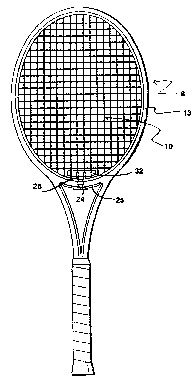Some of the information on this Web page has been provided by external sources. The Government of Canada is not responsible for the accuracy, reliability or currency of the information supplied by external sources. Users wishing to rely upon this information should consult directly with the source of the information. Content provided by external sources is not subject to official languages, privacy and accessibility requirements.
Any discrepancies in the text and image of the Claims and Abstract are due to differing posting times. Text of the Claims and Abstract are posted:
| (12) Patent Application: | (11) CA 2174696 |
|---|---|
| (54) English Title: | SPORTS RACKET |
| (54) French Title: | RAQUETTE DE SPORT |
| Status: | Deemed Abandoned and Beyond the Period of Reinstatement - Pending Response to Notice of Disregarded Communication |
| (51) International Patent Classification (IPC): |
|
|---|---|
| (72) Inventors : |
|
| (73) Owners : |
|
| (71) Applicants : |
|
| (74) Agent: | HAROLD A. SAFFREYSAFFREY, HAROLD A. |
| (74) Associate agent: | |
| (45) Issued: | |
| (22) Filed Date: | 1996-04-22 |
| (41) Open to Public Inspection: | 1997-10-23 |
| Availability of licence: | N/A |
| Dedicated to the Public: | N/A |
| (25) Language of filing: | English |
| Patent Cooperation Treaty (PCT): | No |
|---|
| (30) Application Priority Data: | None |
|---|
This invention relates to an improvement in a split bridge
sports racket having a frame with a rim and a handle, the rim
being formed with string tunnels through which the string extends
to form an impact surface, the handle having a Y configuration,
the arms of which merge with the rim to define a bridge section
of the rim that extends between the ends of the arms of the Y
configuration, the bridge having a discontinuity, the free ends
of the bridge at the discontinuity articulating with a bridge
insert to reduce player arm stress in use. The improvement
resides in providing a bridge having a length to accommodate at
least four central longitudinal string tunnels of the racket with
each central longitudinal string tunnel extending in the same
direction as their respective longitudinal strings through the
said bridge and wherein a support plug is mounted within the
hollow of each of the free ends of the bridge to limit the
movement of the free ends during play and prevent cracking of the
frame from use.
Cette invention concerne une amélioration apportée à une raquette de sport à coeur bibranche et cadre à pont fendu, ledit cadre comportant des tunnels de cordage pour faire passer les cordes qui forment la surface de frappe, le manche ayant un coeur en Y dont les deux branches définissent entre leur point de jonction avec le cadre un pont qui présente en son milieu une solution de continuité. Les extrémités libres du pont s'articulent sur un insert ayant pour rôle d'atténuer les chocs ressentis au bras du joueur. L'amélioration provient de la longueur accrue du pont qui peut comporter au moins quatre tunnels de cordage dans l'axe des cordes longitudinales correspondantes, pont entre les extrémités libres duquel est montée une cheville servant à limiter le déplacement relatif desdits extrémités et à prévenir la fissuration du cadre.
Note: Claims are shown in the official language in which they were submitted.
Note: Descriptions are shown in the official language in which they were submitted.

2024-08-01:As part of the Next Generation Patents (NGP) transition, the Canadian Patents Database (CPD) now contains a more detailed Event History, which replicates the Event Log of our new back-office solution.
Please note that "Inactive:" events refers to events no longer in use in our new back-office solution.
For a clearer understanding of the status of the application/patent presented on this page, the site Disclaimer , as well as the definitions for Patent , Event History , Maintenance Fee and Payment History should be consulted.
| Description | Date |
|---|---|
| Inactive: IPC deactivated | 2015-03-14 |
| Inactive: IPC deactivated | 2015-03-14 |
| Inactive: First IPC from PCS | 2015-01-17 |
| Inactive: IPC from PCS | 2015-01-17 |
| Inactive: IPC from PCS | 2015-01-17 |
| Inactive: IPC expired | 2015-01-01 |
| Inactive: IPC expired | 2015-01-01 |
| Inactive: IPC removed | 2014-11-05 |
| Inactive: IPC from MCD | 2006-03-12 |
| Inactive: IPC from MCD | 2006-03-12 |
| Application Not Reinstated by Deadline | 2002-04-22 |
| Time Limit for Reversal Expired | 2002-04-22 |
| Deemed Abandoned - Failure to Respond to Maintenance Fee Notice | 2001-04-23 |
| Inactive: Cover page published | 2000-12-21 |
| Letter Sent | 1999-05-26 |
| Application Published (Open to Public Inspection) | 1997-10-23 |
| Abandonment Date | Reason | Reinstatement Date |
|---|---|---|
| 2001-04-23 |
The last payment was received on 1999-04-22
Note : If the full payment has not been received on or before the date indicated, a further fee may be required which may be one of the following
Please refer to the CIPO Patent Fees web page to see all current fee amounts.
| Fee Type | Anniversary Year | Due Date | Paid Date |
|---|---|---|---|
| MF (application, 2nd anniv.) - small | 02 | 1998-04-22 | 1998-04-22 |
| MF (application, 4th anniv.) - small | 04 | 2000-04-25 | 1999-04-22 |
| MF (application, 3rd anniv.) - small | 03 | 1999-04-22 | 1999-04-22 |
Note: Records showing the ownership history in alphabetical order.
| Current Owners on Record |
|---|
| CHARLES DICERBO |
| Past Owners on Record |
|---|
| None |